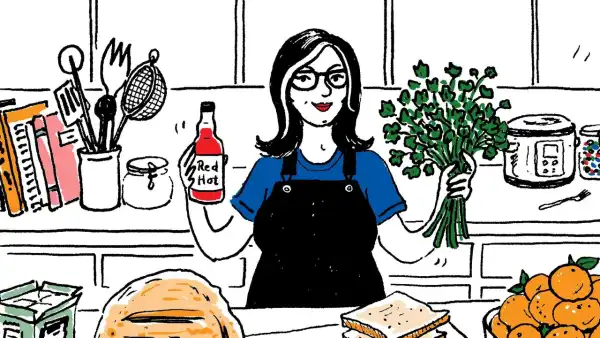
Ever since my mom died, I cry in H Mart. For those of you who don’t know, H Mart is a supermarket chain that specializes in Asian food. The “H” stands for han ah reum, a Korean phrase that roughly translates to “one arm full of groceries.” H Mart is where parachute kids go to get the exact brand of instant noodles that reminds them of home. It’s where Korean families buy rice cakes to make tteokguk, a beef soup that brings in the New Year. It’s the only place where you can find a giant vat of peeled garlic, because it’s the only place that truly understands how much garlic you’ll need for the kind of food your people eat. H Mart is freedom from the single-aisle “ethnic” section in regular grocery stores. They don’t prop Goya beans next to bottles of sriracha here. Instead, you’ll likely find me crying by the banchan refrigerators, remembering the taste of my mom’s soy-sauce eggs and cold radish soup. Or in the freezer section, holding a stack of dumpling skins, thinking of all the hours that Mom and I spent at the kitchen table folding minced pork and chives into the thin dough. Sobbing near the dry goods, asking myself, “Am I even Korean anymore if there’s no one left in my life to call and ask which brand of seaweed we used to buy?”
Growing up mixed-race in America, with a Caucasian father and a Korean mother, my mom was my access point for our Korean heritage. While she never actually taught me how to cook (Korean people tend to disavow measurements and supply only cryptic instructions along the lines of “add sesame oil until it tastes like Mom’s”), she did raise me with a distinctly Korean appetite. This meant an over-the-top appreciation of good food and emotional eating. We were particular about everything: kimchi had to be perfectly sour, samgyupsal perfectly crisped; hot food had to be served piping hot or it might as well be inedible. The concept of prepping meals for the week was a ludicrous affront to our life style. We chased our cravings daily. If we wanted the same kimchi stew for three weeks straight, we relished it until a new craving emerged. We ate in accordance with the seasons and holidays. On my birthday, she’d make seaweed soup: a traditional dish for celebrating one’s mother that is also what women typically eat after giving birth. When spring arrived and the weather turned, we’d bring our camp stove outdoors and fry up strips of fresh pork belly on the deck. In many ways, food was how my mother expressed her love. No matter how critical or cruel she seemed—constantly pushing me to be what she felt was the best version of myself—I could always feel her affection radiating from the lunches she packed and the meals she prepared for me just the way I liked them.
I can hardly speak Korean, but in H Mart I feel like I’m fluent. I fondle the produce and say the words aloud—chamoe melon, danmuji. I fill my shopping cart with every snack that has glossy packaging decorated with a familiar cartoon. I think about the time Mom showed me how to fold the little plastic card that came inside bags of Jolly Pong, how to use it as a spoon to shovel caramel puff rice into my mouth, and how it inevitably fell down my shirt and spread all over the car. I remember the snacks Mom told me she ate when she was a kid and how I tried to imagine her at my age. I wanted to like all the things she did, to embody her completely.
My grief comes in waves and is usually triggered by something arbitrary. I can tell you with a straight face what it was like watching my mom’s hair fall out in the bathtub, or about the five weeks I spent sleeping in hospitals, but catch me at H Mart when some kid runs up double-fisting plastic sleeves of ppeong-twigi and I’ll just lose it. Those little rice-cake Frisbees were my childhood: a happier time, when Mom was there and we’d crunch away on the Styrofoam-like disks after school. Eating them was like splitting a packing peanut that dissolved like sugar on your tongue.
I’ll cry when I see a Korean grandmother eating seafood noodles in the food court, discarding shrimp heads and mussel shells onto the lid of her daughter’s tin rice bowl. Her gray hair frizzy, cheekbones protruding like the tops of two peaches, tattooed eyebrows rusting as the ink fades out. I’ll wonder what my Mom would have looked like in her seventies—if she would have the same perm that every Korean grandma gets as though it were a part of our race’s evolution. I’ll imagine our arms linked, her tiny frame leaning against mine as we take the escalator up to the food court. The two of us in all black, “New York style,” she’d say, her image of New York still rooted in the era of “Breakfast at Tiffany’s.” She would carry the quilted-leather Chanel purse that she’d wanted her whole life, instead of the fake ones that she bought on the back streets of Itaewon. Her hands and face would be slightly sticky from QVC anti-aging creams. She’d wear some strange, ultra-high-top sneaker wedges that I’d disagree with. “Michelle, in Korea, every celebrity wears this one.” She’d pluck the lint off my coat and pick on me—how my shoulders slumped, how I needed new shoes, how I should really start using that argan-oil treatment she bought me—but we’d be together.
If I’m being honest, there’s a lot of anger. I’m angry at this old Korean woman I don’t know, that she gets to live and my mother does not, like somehow this stranger’s survival is at all related to my loss. Why is she here slurping up spicy jjamppong noodles and my mom isn’t? Other people must feel this way. Life is unfair, and sometimes it helps to irrationally blame someone for it.
Sometimes my grief feels as though I’ve been left alone in a room with no doors. Every time I remember that my mother is dead, it feels like I’m colliding into a wall that won’t give. There’s no escape, just a hard wall that I keep ramming into over and over, a reminder of the immutable reality that I will never see her again.
H Marts are usually situated far from a city’s center. When I lived in Brooklyn, it was an hour-long drive in traffic to Flushing. In Philly, it’s about the same to Upper Darby or Elkins Park. H Marts often serve as the center of larger complexes of Asian storefronts, and are surrounded by Asian restaurants that are always better than the ones found closer to town. We’re talking Korean restaurants that pack the table so full of banchan side dishes that you’re forced to play a never-ending game of horizontal Jenga with twenty-plus plates of tiny anchovies, stuffed cucumbers, and pickled everything. This isn’t like the sad Asian-fusion joint by your work, where they serve bell peppers in their bibimbap and give you the stink eye when you ask for another round of wilted bean sprouts; this is the real deal.
You’ll know that you’re headed the right way because there will be signs to mark your path. As you go farther into your pilgrimage, the lettering on the awnings slowly begins to turn into symbols that you may or may not be able to read. This is when my elementary-grade Korean skills are put to the test—how fast can I sound out the vowels while in traffic? I spent more than ten years going to hangul hakkyo every Friday, and this is all I have to show for it: I can read the signs for churches in different Asian texts, for an optometrist’s office, a bank. A couple more blocks in, and we’re in the heart of it. Suddenly, it’s like another country. Everyone is Asian, a swarm of different dialects crisscross like invisible telephone wires, the only English words are “HOT POT” and “LIQUORS,” and they’re all buried beneath a handful of different characters, with an anime tiger or hot dog dancing next to them.
Inside an H Mart complex, there will be some kind of food court, an appliance shop, and a pharmacy. Usually, there’s a beauty counter where you can buy Korean makeup and skin-care products with snail mucin or caviar oil, or a face mask that proudly and vaguely advertises “PLACENTA.” (Whose placenta? Who knows?) There will usually be a pseudo-French bakery with weak coffee, bubble tea, and an array of glowing pastries that always look much better than they taste.
Lately, my local H Mart is in Cheltenham, a town northeast of Philadelphia. My routine is to drive in for lunch on the weekends, stock up on groceries for the week, and cook something for dinner with whatever fresh bounty inspired me. The H Mart in Cheltenham has two stories; the grocery is on the first floor and the food court is above it. Upstairs, there is an array of stalls for different kinds of food. One is dedicated to sushi, one is strictly Chinese, and another is for traditional Korean jjigaes, bubbling soups served in traditional stone pots called dolsots, which act as mini cauldrons to insure that your soup is still bubbling a good ten minutes past arrival. There’s a stall for Korean street food, which serves up Korean ramen (which basically just means Shin Cup Noodles with an egg cracked in them); giant steamed dumplings full of pork and glass noodles, housed in a thick, cake-like dough; and tteokbokki, chewy, bite-sized cylindrical rice cakes boiled in a stock with fishcakes, red pepper, and gochujang, a sweet-and-spicy paste that’s one of the three mother sauces used in pretty much all Korean dishes. Last, there’s my personal favorite: Korean-Chinese fusion, which serves tangsuyuk—a glossy, sweet-and-sour orange pork—seafood noodle soup, fried rice, and jajangmyeon.
The food court is the perfect place to people-watch while sucking down salty, fatty, black-bean noodles. I think about my family who lived in Korea, before most of them died, and how Korean-Chinese food was always the first thing we’d eat when my mom and I arrived in Seoul after a fourteen-hour flight from America. Twenty minutes after my aunt would phone in our order, the apartment ringer would buzz “Für Elise” in MIDI, and up would come a helmeted man, fresh off his motorcycle, with a giant steel box. He’d slide open the metal door and deliver heaping bowls of noodles and deep-fried battered pork with its rich sauce on the side. The Saran wrap on top would be concave and sweating. We’d peel it off and dribble black, chunky goodness all over the noodles and pour the shiny, sticky, translucent orange sauce over the pork. We’d sit cross-legged on the cool marble floor, slurping and reaching over one another. My aunts and mom and grandmother would jabber on in Korean, and I would eat and listen, unable to comprehend, bothering my mom every so often to translate.
I wonder how many people at H Mart miss their families. How many are thinking of them as they bring their trays back from the different stalls. Whether they’re eating to feel connected, to celebrate these people through food. Which ones weren’t able to fly back home this year, or for the past ten years? Which ones are like me, missing the people who are gone from their lives forever?
At one table is a group of young Chinese students, alone without family at schools in America. They have banded together to take the bus forty-five minutes outside the city, into the suburbs of a foreign country, for soup dumplings. At another table, there are three generations of Korean women eating three different types of stews: daughter, mom, and grandmother dipping their spoons into each other’s dolsots, reaching over one another’s trays, arms in one another’s faces, pinching at their different banchan with chopsticks. None of them pay any notice or give second thought to the concept of personal space.
There is a young white man and his family. They giggle together as they butcher the pronunciation of the menu. The son explains to his parents the different dishes they’ve ordered. Maybe he was stationed in Seoul for military service or taught English abroad. Maybe he’s the only one in his family with a passport. Maybe this will be the moment his family decides it’s time to travel and discover these things themselves.
There is an Asian guy blowing his girlfriend’s mind, introducing her to a whole new world of flavors and textures. He shows her how to eat mul naengmyeon, a cold noodle soup that tastes better if you add vinegar and hot mustard first. He tells her about how his parents came to this country, how he’d watch his mom make this dish. When she made it, she didn’t add zucchini, she subbed radishes instead. An old man hobbles over to a neighboring table to order the chicken-and-ginseng porridge that he probably eats here every day. Bells go off for people to collect their orders. Women in visors work behind the counters without stopping.
It’s a beautiful, holy place. A cafeteria full of people from all over the world who have been displaced in a foreign country, each with a different history. Where did they come from and how far did they travel? Why are they all here? To find the galangal no American supermarket stocks to make the Indonesian curry that their father loves? To buy the rice cakes to celebrate Jesa and honor the anniversary of their loved one’s passing? To satisfy a craving for tteokbokki on a rainy day? Were they moved by a memory of some drunken, late-night snack under a pojangmacha tent in Incheon?
We don’t talk about it. There’s never so much as a knowing look. We sit here in silence, eating our lunch. But I know we are all here for the same reason. We’re all searching for a piece of home, or a piece of ourselves. We look for a taste of it in the food we order and the ingredients we buy. Then we separate. We bring the haul back to our dorm rooms or suburban kitchens, and we re-create a dish that couldn’t be made without that journey, because what we’re looking for isn’t accessible at a Trader Joe’s. H Mart is where you can find your people under one odorous roof, where you can have faith that you’ll find something you can’t find anywhere else.
In the H Mart food court, I find myself again, searching for the first chapter of the story that I want to tell about my mother. I am sitting next to a Korean mother and her son, who have unknowingly taken the table next to ol’ waterworks over here. The kid dutifully gets their silverware from the counter and places it on paper napkins for the both of them. He’s eating fried rice and his mom has seolleongtang, ox-bone soup. He must be in his early twenties, but his mother is still instructing him on how to eat, just like my mom used to. “Dip the onion in the paste.” “Don’t add too much gochujang or it’ll be too salty.” “Why aren’t you eating the mung beans?” Some days, the constant nagging would annoy me. Woman, let me eat in peace! But, most days, I knew it was the ultimate display of a Korean woman’s tenderness, and I cherished that love.
The boy’s mom places pieces of beef from her spoon onto his spoon. He is quiet and looks tired and doesn’t talk to her much. I want to tell him how much I miss my mother. How he should be kind to his mom, remember that life is fragile and she could be gone at any moment. Tell her to go to the doctor and make sure there isn’t a small tumor growing inside her.
Within the past five years, I lost both my aunt and mother to cancer. So, when I go to H Mart, I’m not just on the hunt for cuttlefish and three bunches of scallions for a buck; I’m searching for their memory. I’m collecting the evidence that the Korean half of my identity didn’t die when they did. In moments like this, H Mart is the bridge that guides me away from the memories that haunt me, of chemo head and skeletal bodies and logging milligrams of hydrocodone. It reminds me of who they were before: beautiful and full of life, wiggling Chang Gu honey-cracker rings on all ten of their fingers, showing me how to suck a Korean grape from its skin and spit out the seeds.
Sourse: newyorker.com






